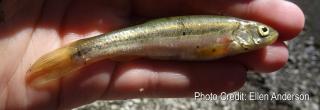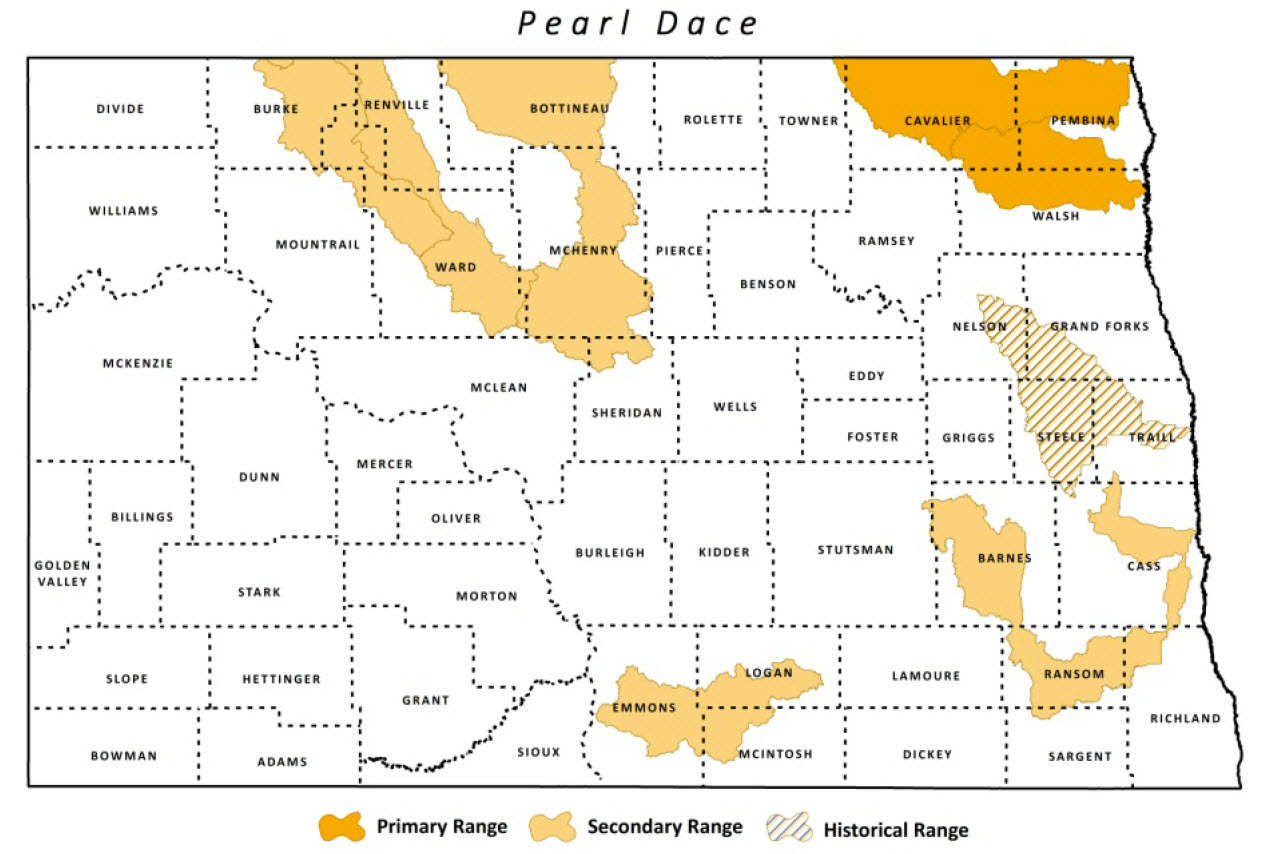
Northern Pearl Dace
Locations and Conditions of Key Habitat
Preferred Habitat
Pearl Dace prefer cool, clear headwater streams 1-3 meters wide and less than 0.5 meters deep. They are associated with pools with slow to moderate current in these streams. Bottom substrate is generally sand or gravel.
Key Areas and Conditions for Northern Pearl Dace in North Dakota
The Pearl Dace has not been recorded in many locations in North Dakota. The Tongue River, a small tributary of the Pembina River in northeastern North Dakota, has a population of Pearl Dace. They have also been recently recorded in Beaver Creek in the Missouri River drainage. Historically they were present in the Park, Goose, Willow, and Souris Rivers but were not documented recently.
Problems Which May Affect this Species
Habitat
Degradation of quality habitat is recognized as the leading cause for decline in this species; specifically, loss and destruction of riparian habitat along waterways caused by changing land use practices.
Other Natural or Manmade Factors
The addition of dams within the Red River drainage has changed the flow regime and also blocks fish movement into suitable habitat. A decline in water quality in the Red River basin may have contributed to the decrease of this species.
Research and Survey Efforts
Current Research or Surveys
- Currently no studies or surveys specifically targeting the Northern Pearl Dace are in progress.
Previous Research or Surveys
- Red River basin streams were surveyed during the 1960s by the University of North Dakota (UND).
- In the late 1970s, Red River basin stream surveys were conducted by the Minnesota Department of Natural Resources, Ecological Services Section (MDNR ECO).
- A survey was conducted on the Red River during 1983 and 1984.
- Investigations of stream fishes in the Red River basin occurred during 1993 and 1994 as a part of two major studies.
- Several sites throughout the basin have been sampled for fishes using electrofishing gear by the MDNR, Minnesota Pollution Control Agency (MPCA), North Dakota Department of Health (NDDH), U.S. Environmental Protection Agency (EPA), and the U.S. Geological Survey (USGS). These studies are a part of the USGS National Water Quality Assessment program (Stoner et al. 1993) and the development of an index of biotic integrity for fishes in the basin (Goldstein et al. 1994).
- A survey of the Sheyenne River and its tributaries within the Sheyenne National Grasslands was conducted by Brooks in 2000.
- South Dakota State University surveyed the stream fish of the Red River and its drainages in 2008.
- South Dakota State University surveyed western North Dakota streams in 2010.
- A survey effort was conducted in the Sheyenne River by Valley City State University in 2012.
- A survey effort was conducted in Baldhill Creek by Valley City State University in 2013.
Additional Research or Surveys Needed
- Re-examine sites where this species has been recorded.
- Develop a protocol to monitor stream fish.
Management Recommendations
- Protect rivers, streams, and riparian areas where possible (i.e. easements and/or acquisition).
- Work with partners to ensure Swampbuster provisions are maintained.
- Continue to use the Section 404 program to ensure affected rivers and riparian areas are mitigated to replace form and function.
- Continue to work with other federal agencies (i.e. FAA and FHWA) not covered by Section 404 or Swampbuster to ensure affected rivers and riparian areas are mitigated to replace form and function.
- Continue to work with NDSWC to develop minimum in-stream flow recommendations.
- Develop and promote incentive programs to restore riparian areas.
- Continue to work with ND 319 Task Force in prioritizing projects within impaired watersheds and implementing BMP’s.
- Develop and promote incentive programs for adjacent landowners to improve bank stability through land use changes (e.g. RRBRP).
- Promote non-traditional bank stabilization measures (i.e. root wads, willow waddles, vegetative slope).
- Implement intake conditions or recommendations (i.e. screening and velocity requirements).
- Work with the dam owners for potential removal or modification.
- Cooperate with Fisheries Division on state aquatic nuisance species plan.
- Survey areas of data gaps. Conduct research/surveys to establish baseline information on SCP.
- Continue to work with partners in promoting and distributing educational materials related to river, stream and riparian values and good stewardship.
Monitoring Plans
No monitoring plan has been identified for this species. The North Dakota Department of Health conducts Index of Biotic Integrity (IBI) for all North Dakota’s watersheds. This will document all species encountered.
2005-2015 Progress
The Northern Pearl Dace maintains a Level I Species of Conservation Priority ranking. SWG T-14-R Status of selected fishes with immediate conservation need in North Dakota provided the important information for this species. Follow up surveys to assess this species status are needed.

Note: A listing of works consulted when compiling the information on this page may be found in the 2015 State Wildlife Action Plan.
